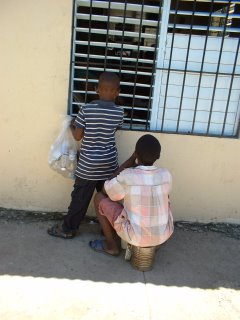Monday, November 21, 2005
Tuesday, November 15, 2005
ある言葉
開発協力を職業としていると、時々「何のため」、「誰のため」にやっているのか、この仕事の存在価値に疑問を感じることがある。のんびり好きで「今日を楽しく生きられればいい」ドミニカ人に、期限付きの開発プロジェクトは全く似合わない気さえする。
今日もそういう場面があり、ゆでたスパゲッティーのようなへたれた気分で、夕方ある女性の家を訪ねた。彼女は20数年前にダハボン市に特殊小学校を創立し、これまで校長として何千もの(主に知的)障害児の教育に関わってきた。この国には、何百という私立特殊学校があるというが、公立特殊学校はダハボンにあるのを含めて4校のみである。慢性予算不足の教育省からは特別な補助金もでないらしく、モノや教員の調整、児童の保護者との連絡等で日々目まぐるしく働いている様子は、2-3分彼女の職場にいれば分かる。
その彼女が、気力の抜けた私に、
Dame serenidad para aceptar lo que no puedo cambiar;
Valor para cambiar lo que puede y debe ser cambiado;
Y sabiduría para distinguir lo uno de lo otro.
Grant me the serenity to accept the things I cannot change;
The courage to change the things I can;
And the wisdom to know the difference.
変えられないことを 受入れる心の穏やかさを
変えられることを 変えてゆく勇気を
そして その両者を見分ける 知恵を 我に与え給え
という言葉をくれた。英語で聞いたことはあったが、スペイン語でそう言われると、ここでもこの言葉が呼吸できる空気があるんだ、となんだか少し元気づけられた。彼女の学校と協力している「障害に対する意識向上キャンペーン」の打ち合わせが訪問の目的だったが、それとは別に、ふにゃんとした気分が少し立ち上がった気持ちで、彼女の家を後にした。
今日もそういう場面があり、ゆでたスパゲッティーのようなへたれた気分で、夕方ある女性の家を訪ねた。彼女は20数年前にダハボン市に特殊小学校を創立し、これまで校長として何千もの(主に知的)障害児の教育に関わってきた。この国には、何百という私立特殊学校があるというが、公立特殊学校はダハボンにあるのを含めて4校のみである。慢性予算不足の教育省からは特別な補助金もでないらしく、モノや教員の調整、児童の保護者との連絡等で日々目まぐるしく働いている様子は、2-3分彼女の職場にいれば分かる。
その彼女が、気力の抜けた私に、
Dame serenidad para aceptar lo que no puedo cambiar;
Valor para cambiar lo que puede y debe ser cambiado;
Y sabiduría para distinguir lo uno de lo otro.
Grant me the serenity to accept the things I cannot change;
The courage to change the things I can;
And the wisdom to know the difference.
変えられないことを 受入れる心の穏やかさを
変えられることを 変えてゆく勇気を
そして その両者を見分ける 知恵を 我に与え給え
という言葉をくれた。英語で聞いたことはあったが、スペイン語でそう言われると、ここでもこの言葉が呼吸できる空気があるんだ、となんだか少し元気づけられた。彼女の学校と協力している「障害に対する意識向上キャンペーン」の打ち合わせが訪問の目的だったが、それとは別に、ふにゃんとした気分が少し立ち上がった気持ちで、彼女の家を後にした。
Wednesday, November 09, 2005
A Haitian Boy (1)
While I was waiting for the reparation of the flat tire, the boy with a
larg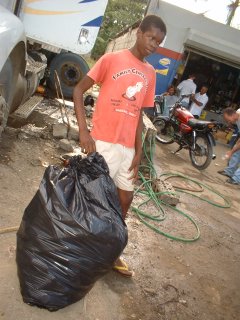 e trash bag approached, collecting empty plastic bottles.
e trash bag approached, collecting empty plastic bottles.
The full bag could be sold at 20 pesos (less than a dollar) or so in Haiti, I was told. I pictured the boy crossing the river (border) with this bag, amongst many other Haitians, and wondered if he had something better to bring home.
ハイチ少年 (1)
パンクしたタイヤの修理を待っていたとき、大きなゴミ袋を引きずった男の子が歩いてきた。空のペットボトルを集めているらしい。一杯になったゴミ袋は、ハイチで20ペソ(60~70円)で売れると修理場のおじさんから聞いた。このゴミ袋と一緒に川(ダハボンからハイチへの国境)を渡る少年の姿を想像して、もう少しいいものを家に持って帰れないものかと思った。
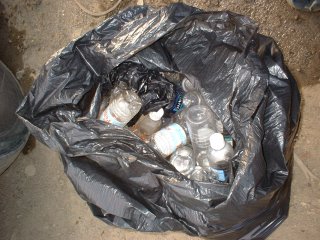
larg
 e trash bag approached, collecting empty plastic bottles.
e trash bag approached, collecting empty plastic bottles.The full bag could be sold at 20 pesos (less than a dollar) or so in Haiti, I was told. I pictured the boy crossing the river (border) with this bag, amongst many other Haitians, and wondered if he had something better to bring home.
ハイチ少年 (1)
パンクしたタイヤの修理を待っていたとき、大きなゴミ袋を引きずった男の子が歩いてきた。空のペットボトルを集めているらしい。一杯になったゴミ袋は、ハイチで20ペソ(60~70円)で売れると修理場のおじさんから聞いた。このゴミ袋と一緒に川(ダハボンからハイチへの国境)を渡る少年の姿を想像して、もう少しいいものを家に持って帰れないものかと思った。

Thursday, November 03, 2005
変化の(不)必要性
村の人たちが変わりたくないんなら、わざわざ外部者が変えようとしなくたっていいじゃないか。どこまでが押し付けにならない、必要とされている(誰にとって?)開発援助なのか。カリブのマイ・ペースだと、1~2年の予算を消費するのに10年かかることだってある。それを国際機関・NGO等が「予定の期間が過ぎました。さあ結果を提示しなさい」と言って結果が出てくるものではない。でもドナーにはドナーの現実があり、国際機関なら資金拠出国に、また政府なら税金を払っている国民にODAの使い道の説明をしないといけない。そして途上国のフィールドには、フィールドの現実と事情が埋まっていて、それには予想できない状況(不測の事態)も多く含まれる。自分だって本部で仕事をしていたときは、マンゴーの季節になると、みんな道端のマンゴーでお腹を満たしてしまうから食料品の売り上げが落ち、ゆえに村の零細企業の農産物加工製品の売り上げも落ちる、なんて考えつかなかった(see the previous entry on Mangoes and Avogadoes)。
Tuesday, November 01, 2005
Mangoes and Avocadoes
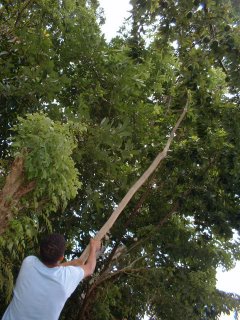
The season of avocadoes, which came after that of mangoes, has almost ended. In this moderate semi-tropical climate, some fruits like papayas and oranges grow all-year-round, but avocadoes and mangoes have their distinct seasons.
Back in April started to appear mangoes. They were literally e-v-e-r-y-where. Regardless of the towns or the countryside, this land is heavily populated by mango trees. Ripen mangoes were dropping from the trees, emitting sweet aroma which later became quite unattractive when they were left out on the ground for a few days.
After mango came avocadoes. During its high season, I ate it almost everyday— with soy sauce and “wasabi” (the seaweed was missing). Dominicans were selling them in buckets in front of their houses, and Haitian women were carrying them on top of their heads, walking around the town.
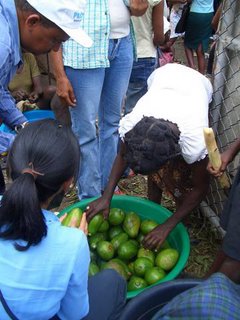
I also have to add that during the mango season, people were eating mangoes everywhere, and there seemed to be no hungry kids. For this reason, the sales of plantain and yucca chips (like potato chips) produced in the small community factory(i) went through a slow sales phase. Why? Because people buy less food (particularly less snacks) as mangoes fulfill their stomach, and the food sales go down. Indeed, I would ask my neighbors how many mangoes they had that day, and the average answer was 7-8! I explained to the headquarters why the sales dropped and the project a bit sluggish in April-July.
(i) It’s the agro-industry component of the project, that aims to enhance income generation capacity of the community.

Photos
Top right: A boy using a long wood to get avocadoes in his backyard.
Mid right: Selecting ripen avocadoes sold by a Haitian woman in the market.
Bottom: Girls eating mangoes in the countryside.
